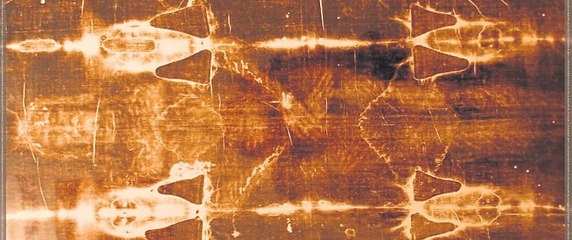Turin Shroud revisited
New evidence has emerged about the Turin Shroud.

It seems the blood stains are not only human but reveal the circumstances of the victim’s death. A scientific article published on a recent study points out that elements in the blood are consistent with ‘polytrauma’. Giulio Fanti concludes: ‘The presence of these biological nanoparticles found during our experiments point to a violent death for the man wrapped in the Turin Shroud.’
Whether such discoveries prove that the ghostly image on the shroud is that of Jesus cannot be so quickly proven, but it adds to a body of data that makes it the stand-out relic of Church history.
Photographic negative
The shroud is a length of cloth on which can be seen the faint image of a man thought to be Jesus of Nazareth. It became famous after a photograph was taken in 1898 and the negative image revealed far more detail than had ever been seen before. Subsequent analysis and tests have confirmed that the image on the shroud is three-dimensional and not a flat painting. Details confirm that it is the image of a real person who suffered wounds all consistent with the description of the trial and execution of Jesus.
The bearded man has suffered bleeding from his scalp, a stab wound in his side, lacerations across his body and nail marks. The photographic negative image resembles an X-ray and reveals a badly bruised face including a swollen nose, distorted cheeks and torn eyelid. If this were a fake then the fraudster was so clever that he faked elements that would not even be detected until centuries after its creation.
Where did it come from?
The origins of the shroud are as mysterious as its present form. The earliest reference to the shroud to which most scholars agree is 1390, when it was referred to as being in France. In 1532 it suffered fire damage in the church where it had been stored. Thereafter it was transferred to Turin, Italy, where it has been held ever since. As the preservation and veneration of relics has been commonplace in the Roman Catholic Church, the authenticity of the shroud has often been the subject of doubt, particularly by Protestants. John Calvin dismissed it on the basis that the Gospel describes Jesus being wrapped in strips rather than a single cloth (John 20.4-7).
An attempt to carbon date the shroud in 1988 suggested that it was from the Middle Ages (1260-1390). These dates aligned with the first uncontroversial reference to the shroud. There seemed good reason to dismiss the artefact as a medieval fake.
How was it produced?
However, even carbon dating could not dampen the fascination with the shroud. If it were a fake then that still raised questions of what it was a fake of and how it could have been artificially produced.
Those who investigate the shroud find details that confound the critics. Minute particles of limestone and pollen found in the shroud match what is known from Jerusalem. In a further twist these elements are also found in another cloth housed in a Spanish Cathedral that is claimed to be the matching head covering also used in the burial process (John 20.7). The 2017 study that has brought the Turin Shroud into the news once more has subjected the traces to such intense study that they have been able to identify organic elements that would accompany torture.
If the shroud is not authentic then how was it produced? Attempts to recreate the shroud using paint or primitive photographic techniques are quite laughable. A 2009 attempt by an Italian Chemistry professor superficially resembled the face of the shroud but lacked any of the detailed features. Closer analysis of the Turin Shroud image reveal no ‘directional-ity’ as you would expect when paint is applied.
Study group
The more that the shroud is subjected to analysis the more reasons emerge to consider it a genuine burial shroud of a torture victim. The number of physicians, pathologists and medics who have offered a positive opinion has continued to grow. Over 100 scientists belong to the Shroud Science Research Group who continue to study it.
The 1988 carbon dating of the shroud never destroyed interest in it, but in 2005 the results were significantly undermined. This later report showed that the 1988 analysis had used a fragment of the shroud from a medieval repair to fire damage. According to Raymond Roger, the author of the 2005 study, the main section of the shroud was between 1,300 and 3,000 years old – much more ancient than the patch that had been tested in 1988.
The Turin Shroud will continue to be the subject of testing and scrutiny. Possible references to the shroud from before 1390 continue to be suggested. The mystery of how the image formed may never be settled but the 2017 contribution confirms that, whatever else the shroud is, it is certainly an image of a real person who suffered a real death in traumatic circumstances.
Evidence of the Gospels
Whether it is the image of Jesus from the first century is impossible to prove. However, its regular appearance in the news and television documentaries certainly demonstrates that there remains a deep public fascination with the historicity of Jesus. While we should not rely on the shroud to prove anything, it certainly illustrates the violence of crucifixion, but for those seeking evidence we can move beyond an ambiguous cloth to the clarity of the written evidence found in the Gospels.
Chris is the D.L. Moody Lecturer in Apologetics, Moorlands College.



